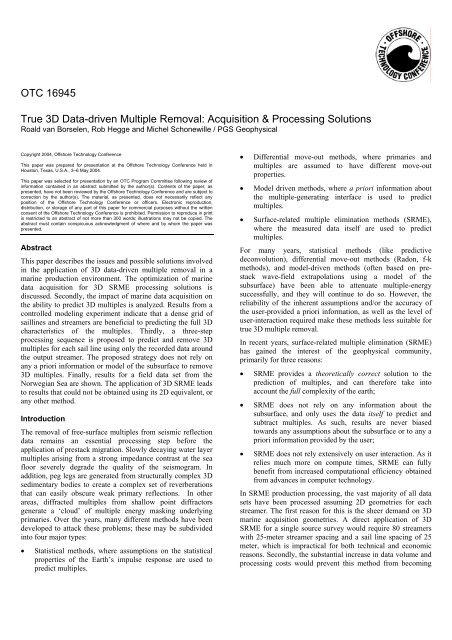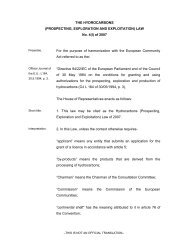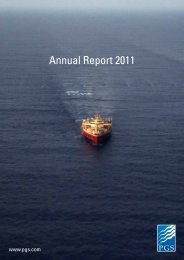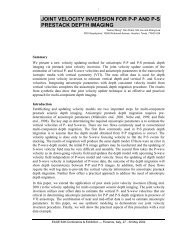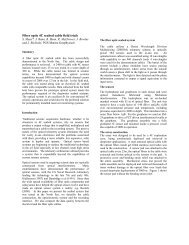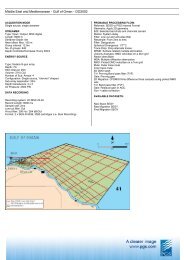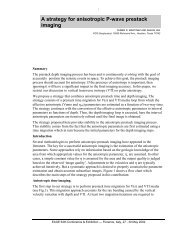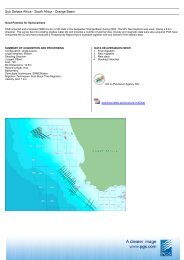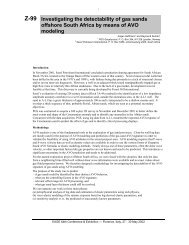OTC 16945 True 3D Data-driven Multiple Removal ... - PGS
OTC 16945 True 3D Data-driven Multiple Removal ... - PGS
OTC 16945 True 3D Data-driven Multiple Removal ... - PGS
Create successful ePaper yourself
Turn your PDF publications into a flip-book with our unique Google optimized e-Paper software.
<strong>OTC</strong> <strong>16945</strong><br />
<strong>True</strong> <strong>3D</strong> <strong>Data</strong>-<strong>driven</strong> <strong>Multiple</strong> <strong>Removal</strong>: Acquisition & Processing Solutions<br />
Roald van Borselen, Rob Hegge and Michel Schonewille / <strong>PGS</strong> Geophysical<br />
Copyright 2004, Offshore Technology Conference<br />
This paper was prepared for presentation at the Offshore Technology Conference held in<br />
Houston, Texas, U.S.A., 3–6 May 2004.<br />
This paper was selected for presentation by an <strong>OTC</strong> Program Committee following review of<br />
information contained in an abstract submitted by the author(s). Contents of the paper, as<br />
presented, have not been reviewed by the Offshore Technology Conference and are subject to<br />
correction by the author(s). The material, as presented, does not necessarily reflect any<br />
position of the Offshore Technology Conference or officers. Electronic reproduction,<br />
distribution, or storage of any part of this paper for commercial purposes without the written<br />
consent of the Offshore Technology Conference is prohibited. Permission to reproduce in print<br />
is restricted to an abstract of not more than 300 words; illustrations may not be copied. The<br />
abstract must contain conspicuous acknowledgment of where and by whom the paper was<br />
presented.<br />
Abstract<br />
This paper describes the issues and possible solutions involved<br />
in the application of <strong>3D</strong> data-<strong>driven</strong> multiple removal in a<br />
marine production environment. The optimization of marine<br />
data acquisition for <strong>3D</strong> SRME processing solutions is<br />
discussed. Secondly, the impact of marine data acquisition on<br />
the ability to predict <strong>3D</strong> multiples is analyzed. Results from a<br />
controlled modeling experiment indicate that a dense grid of<br />
saillines and streamers are beneficial to predicting the full <strong>3D</strong><br />
characteristics of the multiples. Thirdly, a three-step<br />
processing sequence is proposed to predict and remove <strong>3D</strong><br />
multiples for each sail line using only the recorded data around<br />
the output streamer. The proposed strategy does not rely on<br />
any a priori information or model of the subsurface to remove<br />
<strong>3D</strong> multiples. Finally, results for a field data set from the<br />
Norwegian Sea are shown. The application of <strong>3D</strong> SRME leads<br />
to results that could not be obtained using its 2D equivalent, or<br />
any other method.<br />
Introduction<br />
The removal of free-surface multiples from seismic reflection<br />
data remains an essential processing step before the<br />
application of prestack migration. Slowly decaying water layer<br />
multiples arising from a strong impedance contrast at the sea<br />
floor severely degrade the quality of the seismogram. In<br />
addition, peg legs are generated from structurally complex <strong>3D</strong><br />
sedimentary bodies to create a complex set of reverberations<br />
that can easily obscure weak primary reflections. In other<br />
areas, diffracted multiples from shallow point diffractors<br />
generate a ‘cloud’ of multiple energy masking underlying<br />
primaries. Over the years, many different methods have been<br />
developed to attack these problems; these may be subdivided<br />
into four major types:<br />
• Statistical methods, where assumptions on the statistical<br />
properties of the Earth’s impulse response are used to<br />
predict multiples.<br />
• Differential move-out methods, where primaries and<br />
multiples are assumed to have different move-out<br />
properties.<br />
• Model <strong>driven</strong> methods, where a priori information about<br />
the multiple-generating interface is used to predict<br />
multiples.<br />
• Surface-related multiple elimination methods (SRME),<br />
where the measured data itself are used to predict<br />
multiples.<br />
For many years, statistical methods (like predictive<br />
deconvolution), differential move-out methods (Radon, f-k<br />
methods), and model-<strong>driven</strong> methods (often based on prestack<br />
wave-field extrapolations using a model of the<br />
subsurface) have been able to attenuate multiple-energy<br />
successfully, and they will continue to do so. However, the<br />
reliability of the inherent assumptions and/or the accuracy of<br />
the user-provided a priori information, as well as the level of<br />
user-interaction required make these methods less suitable for<br />
true <strong>3D</strong> multiple removal.<br />
In recent years, surface-related multiple elimination (SRME)<br />
has gained the interest of the geophysical community,<br />
primarily for three reasons:<br />
• SRME provides a theoretically correct solution to the<br />
prediction of multiples, and can therefore take into<br />
account the full complexity of the earth;<br />
• SRME does not rely on any information about the<br />
subsurface, and only uses the data itself to predict and<br />
subtract multiples. As such, results are never biased<br />
towards any assumptions about the subsurface or to any a<br />
priori information provided by the user;<br />
• SRME does not rely extensively on user interaction. As it<br />
relies much more on compute times, SRME can fully<br />
benefit from increased computational efficiency obtained<br />
from advances in computer technology.<br />
In SRME production processing, the vast majority of all data<br />
sets have been processed assuming 2D geometries for each<br />
streamer. The first reason for this is the sheer demand on <strong>3D</strong><br />
marine acquisition geometries. A direct application of <strong>3D</strong><br />
SRME for a single source survey would require 80 streamers<br />
with 25-meter streamer spacing and a sail line spacing of 25<br />
meter, which is impractical for both technical and economic<br />
reasons. Secondly, the substantial increase in data volume and<br />
processing costs would prevent this method from becoming
2 <strong>OTC</strong><br />
economically viable. However, due to new insights in the<br />
optimization of data acquisition, increased computer<br />
performance, and a better understanding of the fundamental<br />
steps in the reconstruction of missing data, the industry is now<br />
moving rapidly towards applying the full <strong>3D</strong> implementation<br />
of SRME (see, for example, Hokstad and Sollie (2003), and<br />
Kleemeyer et al. (2003)).<br />
This paper presents an integrated strategy of the application of<br />
<strong>3D</strong> SRME in a production environment. In the first part,<br />
acquisition-related issues are discussed. It is shown how data<br />
can be acquired optimally for the prediction of <strong>3D</strong> multiples.<br />
Also, the impact of data acquisition on the ability to predict<br />
<strong>3D</strong> multiples using SRME is investigated. In the second part, a<br />
processing strategy is presented that can be applied to most <strong>3D</strong><br />
data sets. Finally, the proposed processing strategy is applied<br />
to a field data set from the Norwegian Sea.<br />
Acquisition design criteria for <strong>3D</strong> SRME<br />
To understand the impact of data acquisition on the ability to<br />
predict multiples, it is important to realize how multiples are<br />
predicted using SRME. Figure 1 shows how a typical freesurface<br />
multiple can be predicted by linking (adding) the<br />
raypaths of two events that are present in the measured data.<br />
This linkage is established through a convolution in time, and<br />
the actual position where the linkage takes place is called a<br />
‘multiple contribution’. Note that in order to establish the link,<br />
both source and receiver data must be available. To predict the<br />
multiple trace containing all free-surface multiples that belong<br />
to a source and receiver pair, all convolution results at all<br />
multiple-contribution locations have to be summed. In<br />
practice, after discretization of the wavefield, traces from a <strong>3D</strong><br />
common shot gather need to be convolved with all traces from<br />
a <strong>3D</strong> common receiver gather, and summed. For the correct<br />
prediction of <strong>3D</strong> multiples, the sampling of both the inline and<br />
crossline source and receiver locations needs to satisfy the<br />
Nyquist criteria. In addition, the aperture of the available data<br />
should be sufficient to include all relevant subsurface<br />
reflections, i.e. the Fresnel zone (Van Dedem et al, 2001).<br />
Figure 2 shows the ideal distribution of multiple contributions,<br />
where the aperture of the recorded data extends indefinitely. In<br />
practice, only a sparse distribution of multiple contributions in<br />
the crossline direction is obtained, as sources are only<br />
available on a sparse grid. In addition, only a limited crossline<br />
aperture is available due to the finite number of streamers<br />
used. It is remarked that the inline distribution of multiple<br />
contributions is, in general, sufficient.<br />
The key to the successful application of <strong>3D</strong> SRME is to<br />
maximize the number of multiple contributions in the crossline<br />
direction, to obtain a regular distribution of the multiple<br />
contributions, and to maximize the crossline distance<br />
(aperture) between the two outer multiple contributions.<br />
In marine data acquisition, the main factors controlling the<br />
crossline spatial characteristics of the survey are the<br />
• Number of streamers,<br />
• Streamer separation,<br />
• Sail line spacing,<br />
• Source configuration (single or dual source, and the<br />
spacing between two sources when shooting in dual<br />
source mode).<br />
Figure 3a shows a conventional 8-streamer dual source<br />
configuration, where the sailline spacing is such that<br />
midpoints are not overlapping in the crossline direction. For<br />
the source and receiver combination depicted, the available<br />
three crossline multiple contribution positions are shown. Only<br />
at the positions highlighted can raypaths be connected to<br />
predict the <strong>3D</strong> multiples. Note that changing the streamer<br />
spacing only affects the aperture between the two outer<br />
multiple contributions; it does not change the actual number of<br />
multiple contributions. In Figure 3b, it is shown how the<br />
number of multiple contributions increases when the number<br />
of streamers is increased while keeping the sailline spacing<br />
constant (streamer overlap). Note that, for this source and<br />
receiver combination, the additional two streamers on each<br />
side doubles the number of multiple contributions to six. Note<br />
also that the aperture between the multiple contributions has<br />
doubled as well. Figure 3c shows that by decreasing the sail<br />
line spacing by 50%, the number of multiple contributions can<br />
be increased further to eleven. Additionally, the aperture<br />
between the multiple contributions has increased slightly. As<br />
can be seen, the multiple contributions are now equally<br />
distributed over the aperure due to the additional intermediate<br />
saillines. Finally, in Figure 3d, it is shown how the number of<br />
multiple contributions changes when a single source<br />
configuration is used. Comparing this with Figure 3b (the<br />
same number of streamers and equal sailline spacing), a<br />
decrease in the number of multiple contributions is detected as<br />
the pairs of closely spaced contributions now have become<br />
single multiple contributions. However, it is noted that the<br />
distribution of the remaining contributions over the crossline<br />
aperture remains the same.<br />
Acquisition modeling<br />
To investigate the optimal acquisition geometry for the<br />
application of <strong>3D</strong> SRME, an acquisition modeling tool was<br />
developed.<br />
Figure 4 shows the output of a simple modeling tool that was<br />
designed to compute the relevant diagnostics for the four<br />
acquisition geometries shown in Fig. 3. For each of the<br />
geometries, the first bar shows the number of contributions for<br />
the acquisition geometry under consideration. In this<br />
calculation, all sources within a midpoint spacing from the<br />
receiver line are taken into account. The other bars display the<br />
number of double contributions (i.e. number of secondary<br />
sources that are covered more than once), and the maximum<br />
crossline offsets to both sides that are involved in the multiple<br />
prediction, expressed in number of streamer intervals. From<br />
Fig. 4, it can be seen that by increasing the number of<br />
streamers and by reducing the sailline spacing, the number of<br />
multiple contributions increases for all streamers, where the<br />
highest number of multiple contributions occur at the inner<br />
streamers. Note from Fig. 4d that, even with some subsurface<br />
overlap, single source configurations leads to the situation
<strong>OTC</strong> 3<br />
where only two multiple contributions are available to predict<br />
<strong>3D</strong> multiples for the outer streamers.<br />
It should be noted that for a sailline spacing larger than twice<br />
the streamer separation, the amount of contributions can be<br />
increased artificially by applying some lateral shifts. In this<br />
way, one source of a neighboring streamer will act as<br />
secondary source for the two closest streamers.<br />
It is also remarked that the findings are independent of the<br />
actual streamer spacing as long as the sail line spacing is an<br />
integer multiple of the streamer spacing to obtain a repeatable<br />
pattern. The number of contributions will remain the same;<br />
only the crossline offsets and aperture will change<br />
accordingly.<br />
Finally, for dual source configurations, increasing the spacing<br />
between two sources may lead to a significant increase in both<br />
the aperture and the number of multiple contributions.<br />
However, this only applies to the hypothetical (and extremely<br />
uneconomical) case where the streamer spacing equals the sail<br />
line spacing. By putting both sources on one side of the<br />
streamers, the number of multiple contributions is reduced<br />
considerably. The contributions become very non-symmetric,<br />
which will be non-ideal for any <strong>3D</strong> SRME implementation.<br />
The impact of acquisition on the prediction of <strong>3D</strong> multiples<br />
In this subsection, the impact of the distribution of multiple<br />
contributions on the ability to predict <strong>3D</strong> multiples is<br />
investigated. Because of the simplicity of the model used,<br />
insight is obtained in the general capabilities of interpolation<br />
and/or reconstruction methods to predict <strong>3D</strong> multiples when<br />
only sparse data are available.<br />
In this example, the subsurface model consists of one plane<br />
layer dipping 4 degrees in the crossline direction only. <strong>Data</strong><br />
were modeled for a dual source 16-streamer configuration<br />
with 50 meter streamer separation, with 200 meter and 400<br />
meter sailline separation respectively. Note that for this<br />
streamer configuration, 400 meter sail line spacing gives<br />
conventional sub-surface coverage with no duplication in the<br />
crossline direction. Figure 5a shows the ideal crossline<br />
multiple contribution gather for a source and receiver<br />
combination with 0 meter inline offset and 12.5 meter<br />
crossline offset. Figures 5b-c show, for the same source and<br />
receiver combination, the 7 and 3 crossline multiple<br />
contributions available for a 200 and 400 meter sailline<br />
separation respectively. Figure 6a shows a common shot<br />
gather for the inner streamer, and Fig. 6b shows the<br />
corresponding multiples, predicted using a 2D SRME<br />
approach. Figure 6c shows the ideal <strong>3D</strong> multiples, and Figs.<br />
6d-e show the reconstructed multiples from the 200 and the<br />
400 meter sailline configuration respectively. Note that for<br />
both configurations, the <strong>3D</strong> multiples were reconstructed<br />
satisfactory. Figures 7 and 8 shows the same results for the<br />
outer streamer. Note from Fig. 7b-c that the 5 contributions<br />
from the 200 meter sailline configuration (spaced at –362.5, –<br />
212.5, –162.5, –12.5 and 37.5 meters) are more equally<br />
distributed in the crossline direction than the 3 contributions<br />
from the 400 meter sailline configuation (spaced at –362.5, –<br />
12.5 and 37.5 meters). From Fig. 8b it can be seen that the 2D<br />
multiples are predicted too late in time. Also note that the<br />
results for the 200 meter sailline separation, shown in Figure<br />
8d, are significantly better then for the 400 meter separation<br />
shown in Figure 8e. This is due both to the increased number<br />
of contributions available (5 contributions for the 200 meter<br />
sailline separation versus 3 for the 400 meter separation), and<br />
the better distribution of the multiple contributions over the<br />
total aperture from the 200 meter configuration. However, for<br />
the data with 400 meter sailline separation, the second<br />
multiple is predicted much better than with 2D SRME, and<br />
although the wavelet of the first multiple is distorted, the<br />
timing is good. Therefore we would still expect <strong>3D</strong> SRME to<br />
perform better than 2D SRME, even for the outer streamer.<br />
Recommendations for acquisition<br />
In <strong>3D</strong> data-<strong>driven</strong> multiple removal, the multiple contributions<br />
(defined as locations where both receiver and source data are<br />
available) are the only data available to predict the <strong>3D</strong><br />
multiples. Hence, the distribution of multiple contributions<br />
will govern the quality of the final predicted <strong>3D</strong> multiple trace.<br />
Results from synthetic modeling indicate that a denser grid of<br />
multiple contributions leads to a better prediction of the <strong>3D</strong><br />
multiples.<br />
During marine acquisition, the distribution of the crossline<br />
multiple contributions can be optimized for the application of<br />
<strong>3D</strong> SRME by<br />
• Shooting overlap (by increasing the number of streamers<br />
while keeping the sailline spacing constant);<br />
• Decreasing the sailline spacing;<br />
• Keeping the sailline spacing an integer multiplication of<br />
the streamer spacing;<br />
• Increasing the spread length<br />
For a more complex subsurface, it is therefore recommended<br />
to create a dense grid of multiple contributions with sufficient<br />
aperture to reconstruct the full complexity of the <strong>3D</strong> multiples<br />
successfully.<br />
A processing strategy for <strong>3D</strong> SRME<br />
This section describes an efficient processing sequence to<br />
apply <strong>3D</strong> SRME in a production environment. A three-step<br />
sequence is proposed to predict and remove <strong>3D</strong> multiples for<br />
each sail line using only the recorded data around the output<br />
streamer. Even though the proposed sequence will benefit<br />
from any form of acquisition optimization, the strategy is<br />
designed to handle <strong>3D</strong> data sets that were acquired from<br />
conventional marine acquisition. The three steps involved are<br />
discussed in the following three subsections.<br />
Step 1: Pre-processing<br />
The pre-processing sequence starts with an analysis of the<br />
navigation data to investigate the positioning of the source and<br />
receivers. When irregularities (due to feathering and other<br />
positioning errors, such as drop-outs) are severe, wavefield<br />
regularization should be applied as part of the pre-processing<br />
sequence to position sources and receivers onto a regular pre-
4 <strong>OTC</strong><br />
defined grid. A data-<strong>driven</strong> regularization method, such as<br />
described in Schonewille et al. (2003) that uses the exact<br />
source- and receiver coordinates and allows for regularization<br />
to any user-defined grid is preferred. The proposed preprocessing<br />
sequence is very similar to the well-established<br />
pre-processing for the application of 2D SRME to marine data.<br />
The sequence includes: the removal of the direct wave and its<br />
surface reflection, the removal of non-physical noise and the<br />
directivity effects from source- and receiver arrays (optional),<br />
the recovery of missing shots and intermediate missing traces,<br />
shot interpolation (optional), and the extrapolation to zero<br />
offset of the inline component of the offsets. It is remarked<br />
that, after the optimal sequence and parameterizations have<br />
been found, all steps can be integrated into standardized flows<br />
to increase computational efficiency, and to minimize user<br />
interaction.<br />
Step 2: <strong>Multiple</strong> prediction through reconstruction in the<br />
crossline direction<br />
After pre-processing, the stacking of the multiple-contribution<br />
traces is carried out in two steps, first in the inline direction<br />
and secondly in the cross-line direction. Stacking of the<br />
multiple contribution traces in the inline direction is<br />
straightforward, as the sampling after pre-processing is<br />
sufficient. However, a direct Fresnel summation in the<br />
crossline direction leads to artifacts due to aliasing and<br />
insufficient aperture. Instead, the crossline summation is<br />
carried out implicitly through a reconstruction of the Fresnel<br />
zone, from a sparse-inversion based estimation of hyperbolic<br />
or parabolic events, with discrete curvatures and apex<br />
positions.<br />
In the literature, three methods for sparse-inversion based<br />
Fresnel zone reconstruction have been described: 1) using a<br />
time domain hyperbolic Radon transform (van Dedem and<br />
Verschuur, 2001); 2) using a frequency domain parabolic<br />
Radon transform (Hokstad and Sollie 2003); and 3)<br />
interpolation using Stolt migration operators (Trad, 2003). The<br />
time-domain approach has been shown to provide good results<br />
for <strong>3D</strong> SRME, but is rather expensive. The frequency domain<br />
approach is computationally much more efficient, and has<br />
been shown to provide a good uplift compared with 2D SRME<br />
(Hokstad, 2003). However, using the frequency domain<br />
approach, only sparseness in the spatial direction can be<br />
enforced (Cary 1998, Trad 2003). As a result, for more<br />
complex data with events at many different apex positions,<br />
results may not be as good as with the time-domain approach.<br />
Interpolation with Stolt operators can provide sparseness in<br />
both time and space. The basic algorithm is computationally<br />
very efficient, but shows artifacts. These artifacts can be<br />
reduced, but this does increase the computational costs<br />
somewhat. This is a relatively new technique, and the<br />
suitability for <strong>3D</strong> SRME is under further investigation.<br />
As the reconstruction has to be carried out for all source and<br />
receiver combinations, computational efficiency is vital for the<br />
economical viability of sparse-inversion based <strong>3D</strong> SRME. In<br />
this paper, an approach is used that is based on the standard<br />
time domain approach described by van Dedem and Verschuur<br />
(2001) but which is much more computationally efficient. The<br />
computational speedup has been achieved through more<br />
efficient sparse matrix computations in a modified conjugate<br />
gradient scheme, and a data <strong>driven</strong> reduction of the model<br />
space. The results are comparable to those from using the<br />
standard time domain approach, and show significant<br />
improvements over any 2D implementation.<br />
After stacking the multiple-contribution traces in the Fresnel<br />
zone, a single trace with the corresponding predicted multiples<br />
is obtained, which can be used in the last step: the adaptive<br />
subtraction of the predicted multiples from the input data.<br />
Step 3: Adaptive subtraction of predicted multiples<br />
In the last step, the predicted free-surface multiples are<br />
subtracted from the input data using the minimum energy<br />
criterion, which states that the total energy after subtraction of<br />
the multiples should be minimized. In adaptive subtraction<br />
techniques, the predicted multiples are removed using Wiener<br />
filters designed in overlapping windows. In general, great care<br />
must be taken in choosing the filter length and the window<br />
size. If the filter length is too long, it is possible to remove<br />
primaries. Also, choosing too small a design window may lead<br />
to primary energy being affected when multiples and primaries<br />
are interfering. In <strong>3D</strong> geometries, the application of 2D<br />
multiple prediction methods leads to multiples that are<br />
predicted too late in time. Using a <strong>3D</strong> prediction scheme, the<br />
timing of the predicted multiples is better aligned with the<br />
multiples in the input data, leading to better removal of<br />
multiples. The more accurate timing of the predicted multiples<br />
allows the use of more conservative parameters in the adaptive<br />
subtraction, giving better preservation of primary energy.<br />
Field data example from the Norwegian Sea<br />
In this section, results from a <strong>3D</strong> data set from the Norwegian<br />
Sea are shown. <strong>Data</strong> were shot in a dual-source 10-streamer<br />
configuration, with a 100 meter streamer separation and 500<br />
meter sailline separation. Results for a single offset line for<br />
one of the streamers have already been presented in Van<br />
Dedem and Verschuur (2001). Here, a total of 159 offset<br />
planes with a spacing of 12.5 meters were processed to allow<br />
further prestack processing after the application of <strong>3D</strong> SRME.<br />
Figure 9 shows the results for a typical shot gather. Figure 9a<br />
shows the input gather after pre-processing. Figure 9b-c show<br />
the predicted multiples after 2D and <strong>3D</strong> SRME respectively. A<br />
comparison indicates that, where the 2D multiples have all<br />
been predicted too late in time, the timing of the <strong>3D</strong> predicted<br />
multiples is almost perfect. Figures 9d-e show the results after<br />
adaptive subtraction using the 2D and <strong>3D</strong> predicted multiples<br />
respectively. It is remarked that a very mild adaptive<br />
subtraction approach was used in order to preserve the primary<br />
energy as much as possible. Note the much-improved removal<br />
of multiple-energy using the <strong>3D</strong> predicted multiples. As a<br />
result, the remaining primaries have become much more<br />
visible. Figure 10 shows the same comparison for an inline at<br />
stack level. Note again the difference in timing between the<br />
2D and <strong>3D</strong> predicted multiples, shown in Figs. 10b and c. As a<br />
result, after adaptive subtraction, the <strong>3D</strong> result compares<br />
favorably to the 2D results. Both the first-order water bottom<br />
multiple (between 1.0 and 1.2 second), and the reverberations
<strong>OTC</strong> 5<br />
off the elevated structure between 3 and 4 seconds have been<br />
removed well after <strong>3D</strong> SRME. Furthermore, the diffracted<br />
multiples that have been generated by shallow subsurface<br />
diffractors have been attenuated better using <strong>3D</strong> SRME.<br />
Conclusions<br />
The aim of <strong>3D</strong> data-<strong>driven</strong> multiple removal is to predict<br />
multiples by relying only on the measured data. To reconstruct<br />
the <strong>3D</strong> multiples, no subsurface model, or any other type of a<br />
priori information should be used that could possibly bias the<br />
results of the method. As the multiple contributions (defined<br />
as locations where both receiver and source data are available)<br />
are the only data available to predict the <strong>3D</strong> multiples, it is<br />
evident that the distribution of the multiple contributions will<br />
govern the quality of the final predicted <strong>3D</strong> multiple trace.<br />
In general, the inline wavefield sampling is sufficient and does<br />
not require any optimization for the application of <strong>3D</strong> SRME.<br />
The crossline distribution of multiple contributions however is<br />
often (extremely) sparse. By increasing the number of<br />
streamers per sail line, and by decreasing the sail line spacing<br />
the crossline distribution of multiple contributions can be<br />
optimized.<br />
For the prediction of complex multiples patterns, it is<br />
recommended to create a dense grid of multiple contributions<br />
with sufficient crossline aperture to reconstruct the full<br />
complexity of the <strong>3D</strong> multiples successfully, even though this<br />
may have some cost implications.<br />
Furthermore, a marine processing strategy for the application<br />
of <strong>3D</strong> SRME has been presented. The sequence consists of<br />
three steps: pre-processing of the <strong>3D</strong> data, prediction of<br />
multiples using a sparse-inversion based reconstruction<br />
method, and a (standard) adaptive subtraction of the <strong>3D</strong><br />
predicted multiples from the input data. The proposed strategy<br />
is designed to handle <strong>3D</strong> data sets that were acquired from<br />
both optimized and conventional marine acquisition.<br />
Application of <strong>3D</strong> SRME using the proposed sequence leads<br />
to good results that compare favourably to results obtained<br />
from 2D SRME, or any other method.<br />
Compute times, although still significantly higher than for 2D<br />
SRME, now justify consideration of <strong>3D</strong> SRME application in<br />
a production environment.<br />
68th Ann. Internat. Mtg. SEG, Exp. Abstracts.<br />
Hokstad, K., and Sollie, R., 2003. 3-D surface-related multiple<br />
elimination using parabolic sparse inversion: 73rd. Ann.<br />
Internat. Mtg. SEG. Exp. Abstracts.<br />
Kleemeyer, G., Pettersson, S.E., Eppenga, R., Haneveld, C.J.,<br />
Biersteker, J., and Den Ouden, R., 2003, It’s Magic, Industry<br />
First <strong>3D</strong> Surface <strong>Multiple</strong> Elimination and Pre-stack Depth<br />
Migration on Ormen Lange: 65 th Ann. Internat. Mtg. EAGE.<br />
Schonewille, M.A., Romijn, R., Duijndam, A.J.W. and<br />
Ongkiehong, L., 2003, A general reconstruction scheme for<br />
dominant azimuth <strong>3D</strong> seismic data: Geophysics, Soc. of Expl.<br />
Geophys., 68, 2092-2105.<br />
Trad D., 2003. Interpolation and multiple attenuation with<br />
migration operators: Geophysics 68, 2043-2054.<br />
Van Borselen, R.G. Schonewille M., and Hegge R., 2004. The<br />
impact of marine data acquisition on the prediction of<br />
multiples in <strong>3D</strong> SRME: 66 th Ann. Internat. Mtg. EAGE<br />
(submitted).<br />
Van Borselen, R.G. and Verschuur, D. J., 2003. Optimization<br />
of Marine <strong>Data</strong> Acquisition for the Application of <strong>3D</strong> SRME:<br />
74th Ann. Internat. Mtg. SEG, Exp. Abstracts.<br />
Van Dedem, E., and Verschuur, D., 2001. 3-D surface<br />
multiple prediction using sparse inversion: 71st Ann. Internat.<br />
Mtg. SEG, Exp. Abstracts.<br />
Acknowledgements<br />
The authors like to thank Eric Verschuur and Ewoud van<br />
Dedem from the DELPHI consortium for their contributions.<br />
Also, Peter van den Berg from Delft University is thanked for<br />
his contribution to this work. Finally, Dave King and David<br />
Hedgeland are thanked for their contributions and suggestions.<br />
References<br />
Berkhout A.J. and Verschuur D.J., Estimation of multiple<br />
scattering by iterative inversion, part 1: Theoretical<br />
considerations, Geophysics, 62, pp. 1586-1595.<br />
Cary, P.W., 1998. The simplest discrete Radon transform:
6 <strong>OTC</strong><br />
<strong>Multiple</strong> contribution<br />
↓<br />
↓ ↓<br />
Δ<br />
Δ<br />
Δ<br />
=<br />
-1 .<br />
∗<br />
Figure 1: <strong>Multiple</strong> prediction through linkage of raypaths.<br />
Figure 2: Ideal distribution of multiple contributions.<br />
Figure 3a: Conventional 8-streamer, dual source configuration.<br />
Figure 3b: 12-streamer with overlap, dual source configuration.<br />
Figure 3c: 12-streamer with overlap, dual source configuration<br />
and with reduced (halved) sailline spacing.<br />
Figure 3d: 12-streamer with overlap, single source configuration.
<strong>OTC</strong> 7<br />
800<br />
ysrc=-30 30 : nyrcv=8 : dyrcv=100 : dysail=400<br />
1000<br />
ysrc=-30 30 : nyrcv=12 : dyrcv=100 : dysail=400<br />
600<br />
800<br />
crossline location (m)<br />
400<br />
200<br />
0<br />
-200<br />
-400<br />
crossline location (m)<br />
600<br />
400<br />
200<br />
0<br />
-200<br />
-400<br />
-600<br />
-600<br />
-800<br />
-800<br />
-500 0 500 1000 1500 2000<br />
inline location (m)<br />
-1000<br />
-500 0 500 1000 1500 2000<br />
inline location (m)<br />
12<br />
12<br />
10<br />
10<br />
8<br />
8<br />
6<br />
6<br />
4<br />
4<br />
2<br />
2<br />
0<br />
0<br />
-2<br />
-2<br />
-4<br />
-6<br />
-8<br />
contributions<br />
double contributions<br />
max streamer offset<br />
min streamer offset<br />
1 2 3 4 5 6 7 8<br />
streamer number<br />
-4<br />
-6<br />
-8<br />
contributions<br />
double contributions<br />
max streamer offset<br />
min streamer offset<br />
1 2 3 4 5 6 7 8 9 10 11 12<br />
streamer number<br />
Figure 4a: Diagnostics for an 8-streamer, dual source<br />
configuration.<br />
Figure 4b: Diagnostics for a 12-streamer with overlap, dual source<br />
configuration.<br />
1500<br />
ysrc=-30 30 : nyrcv=12 : dyrcv=100 : dysail=200<br />
1000<br />
ysrc=1 : nyrcv=12 : dyrcv=100 : dysail=400<br />
800<br />
1000<br />
600<br />
crossline location (m)<br />
500<br />
0<br />
-500<br />
crossline location (m)<br />
400<br />
200<br />
0<br />
-200<br />
-400<br />
-1000<br />
-600<br />
-800<br />
-1500<br />
-1000 0 1000 2000 3000 4000<br />
inline location (m)<br />
12<br />
10<br />
8<br />
6<br />
4<br />
2<br />
0<br />
-2<br />
-4<br />
-6<br />
-8<br />
contributions<br />
double contributions<br />
max streamer offset<br />
min streamer offset<br />
1 2 3 4 5 6 7 8 9 10 11 12<br />
streamer number<br />
Figure 4c: Diagnostics for a 12-streamer with overlap, dual source<br />
configuration with reduced (halved) sailline spacing.<br />
-1000<br />
-500 0 500 1000 1500 2000<br />
inline location (m)<br />
12<br />
10<br />
8<br />
6<br />
4<br />
2<br />
0<br />
-2<br />
-4<br />
-6<br />
-8<br />
contributions<br />
double contributions<br />
max streamer offset<br />
min streamer offset<br />
1 2 3 4 5 6 7 8 9 10 11 12<br />
streamer number<br />
Figure 4d: Diagnostics for a 12-streamer with overlap, single<br />
source configuration.
8 <strong>OTC</strong><br />
a) b) c)<br />
Figure 5: a) Ideal crossline multiple contribution gather for a chosen source and receiver combination with zero<br />
inline offset and 25 crossline offset , b) the corresponding 7 available multiple contributions for an inner streamer<br />
from a 16-streamer, dual source configuration with 200 meter sailline separation, c) the corresponding 3 available<br />
multiple contributions for an inner streamer from a 16-streamer, dual source configuration with a 400 meter sailline<br />
separation.<br />
a) b) c) d) e)<br />
Figure 6: a) Shot gather from the inner streamer of a 16-streamer configuration, b) The predicted multiples from<br />
2D SRME, c) The ideal <strong>3D</strong> multiples, d) The reconstructed multiples from the 200 meter sailline separation<br />
configuration, e) The reconstructed multiples from the 400 meter sailline separation configuration.
<strong>OTC</strong> 9<br />
a) b)<br />
c)<br />
Figure 7: a) Ideal crossline multiple contribution gather for a chosen source and receiver combination with 0<br />
meter inline offset and 362.5 meter crossline offset , b) the corresponding 5 available multiple contributions<br />
for an outer streamer from a 16-streamer, dual source configuration with 200 meter sailline separation, c) the<br />
corresponding 3 available multiple contributions for an outer streamer from a 16-streamer, dual source<br />
configuration with a 400 meter sailline separation.<br />
a) b) c) d) e)<br />
Figure 8: a) Shot gather from the outer streamer of the same 16-streamer configuration, b) The predicted<br />
multiples from 2D SRME, c) The ideal <strong>3D</strong> multiples, d) The reconstructed multiples from the 200 meter sailline<br />
separation configuration, e) The reconstructed multiples from the 400 meter sailline separation configuration.
10 <strong>OTC</strong><br />
a) b) c) d e)<br />
Figure 9: a) Typical shot gather after pre-processing. b) Predicted multiples from 2D SRME. c) Predicted multiples using <strong>3D</strong> SRME.<br />
Note that the multiples are better aligned with the multiples in the input data. d) Same shot gather after subtraction of the 2D<br />
multiples. e) Shot gather after subtraction of the <strong>3D</strong> multiples. Note the better removal of multiples while preserving the primaries.<br />
a) b) c)<br />
Figure 10: a) Two zoomed sections of the stack after pre-processing. b) Zoomed stacks of the predicted multiples<br />
from 2D SRME. Note that the 2D multiples are predicted too late in time. c) Stacks of the predicted multiples using <strong>3D</strong><br />
SRME. Note that the <strong>3D</strong> multiples are better aligned with the multiples in the pre-processed data.
<strong>OTC</strong> 11<br />
d)<br />
e)<br />
Figure 10: d) Stacked section after prestack adaptive subtraction of the 2D multiples. Note that the<br />
first-order water bottom multiple, and the multiples off the elevated structure in the deeper section<br />
remain clearly visible. e) Stacked section after prestack subtraction of the <strong>3D</strong> multiples. Note the<br />
better removal of the water bottom multiple in the shallow section. Also, reverberations from the<br />
elevated structure in the deeper section have been removed better, as well as the diffracted multiples<br />
generated by shallow subsurface diffractors. The gathers shown in Figure 9 correspond to a CMP<br />
location of about 50.


